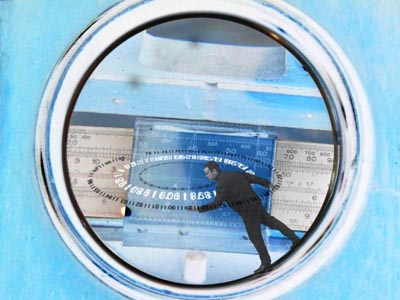








|
Transer (Lyon - Sex�rd), 2001
Video-installation
In the spring of 1968 an energy researcher named G. Bremer looked up the Path� film corporation and a wine dealer called Nicolo to get them to support his idea. His goal was to develop a rolling lifting device, with which to connect Lyon and Szeksz�rd, so he would be able to import wine in a very, very (tr�s-tr�s) economical way. The two cities are located on the same longitude: this is what he based his idea on. If they would build a cable railway between the two cities and at the appropriate distances insert his rolling device, they would be able to transport wine from Szeksz�rd to Lyon. If you calculate the rotation of the globe and the lifting device into the picture, you can transport almost anything virtually for "free". With the black and white film he received from the film company he started from Lyon on foot. He traveled only at night so he could lay the film "tracks" for this blend of the cosmos and ecology. It wasn't the lack of support but the heated events in Paris that finally diverted him: near Vicenza, at Schio, he got on a train with his students and disappeared. We know virtually nothing more of his future fate.

We have no real picture of G. Bremer. Supposedly he said, "... I am the Van Gogh of physical engineering..., a pioneer no one acknowledges, but in the future, my works will be unavoidable. [...] I do not wish to follow in [Van Gogh's] footsteps in all respects, but I believe the photography of the human figure to be a type of magic that I reject..."
For a long time he hesitated in naming his greatest invention, but finally out of pressure, he chose the name (acronym?) "Transer". According to the narrative of his most loyal disciple, M. Soigniet, he introduced the peripatetic system at one of his first classes. "...The university must step out from the boundaries of its walls. [...] how could we possibly understand the world in studios, laboratories, academies..." On one occasion he chose as a picnic site a field located next to an oil pipe connected to an oil refinery. There the class settled down and unpacked the contents of their baskets. Bremer's unusual silence made the students quiet as well. Without a word, they buttered their bread, poured the wine, and enjoyed the hot September day. Later Bremer gave a long lecture. According to the notes of another close disciple of his, C. Lascaux, this is when he formulated the idea of the Transer, the geo-movement transportation device. He explained that the reinterpretation of communication is for physics what the combination of Vedic theories and research formulated on light-based cell communication was in the 1930s. He said, "...if we recognize the natural movement idea of things, we will be able to solve problems which are most important to us in an economic way. Cells communicate with light in a network; this is the physical side of biology. We too must develop transportation systems using the smallest amount of friction, where-- just like the oil pipe-- the goods transported use some sort of natural energy. The perpetual rotation of the earth is one of these obvious energies..."
The students found Bremer confusing and ambiguous. Weeks later they stayed in the lab during a class. This is when a miniature model of the Transer was first presented. The blackboard was thick with calculations and in front of it was the model affixed to a globe. By this time Bremer's reputation had increasingly declined in the eyes of his colleagues. According to Lascaux, this was the reason he had to include sponsors in his plans. Through the connections of his sister Eva, he came into contact with Nicolo from Lyon, also considered to be somewhat of a dreamer, who, since then, is more famous for his Mouton-Rouget than his involvement as one of the first sponsors of the Transer. They both agreed that the invention based on the facts of astronomy must be made comprehensible to the public. His supporters from the film industry helped them make their promotion film mapping the movements of the stars and planets. Nicolo was an ardent fan of Strindberg, whose photograms they used as a base. "If we were to lay sensitive, 35mm film down on the entire length of the experimental course, we could see a recording of the earth's movement. Though the film should be and must be projected, it can also have a place as an object of exhibition, providing a convincing, palpable symbol of the Transer..."
The main goal of the work is the reconstruction of the researcher's character with all remaining documents. I would like to exhibit all the documents in my possession: the film, the plans, a short section of an interview, and his notes.
L�szl� L�szl� R�v�sz
| |

